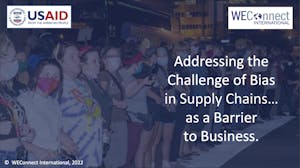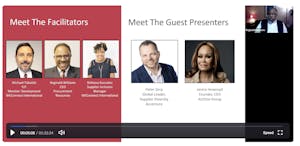en

Bias is pervasive and undeniable. It will take business leaders, policymakers, decision-makers, individuals, educators – everyone! – working together to stamp it out of society. We have a long way to go, but we made some progress recently that I’m particularly proud of.
Recently, WEConnect International and the United States Agency for International Development (USAID) hosted a virtual training and roundtable discussion, “Addressing Challenge of Bias in Supply Chains as a Barrier to Business.” Click here to view the recording of the event and here to view the presentation slides.
The 90-minute event with 84 attendees was facilitated by Reginald Williams, CEO of Procurement Resources, with guest presenters Peter Zerp, Accenture Global Leader for Supplier Diversity, and Janice Howroyd, AgileOne Group Chairperson. Brittany Gonzalez, WEConnect International Supplier Inclusion Manager, and I hosted an interactive discussion with these thought leaders on bias in supply chains relative to supplier diversity and inclusion and provided solutions for removing obstacles for women and other diverse-owned businesses.
Many powerful insights were shared and the event affirmed my belief that bias is one of the most significant barriers for women-owned businesses today—one of the many reasons why I have dedicated significant time and energy to educating people on the topic with the goal of helping them become aware of both the conscious and unconscious biases that exist in our value chains and how best to mitigate bias in the world.
The reality of the negative impact of bias on women-owned businesses worldwide is just as disappointing as it is overwhelming; it seems that most individuals do not understand what bias is and its impact on society, business and our global and local economies. Even worse perhaps, others live in denial by refusing to acknowledge that bias happens everywhere and every day, even in their own workplaces and communities.
Data and statistics support my global observations that bias, both conscious and unconscious, is a significant barrier to women-owned businesses. For example, more than one-third of all privately held businesses in the world are owned by women, yet women-owned enterprises earn less than 1% of contract opportunities with large corporate and government purchasing organizations on a global scale.
It is undeniable—bias poses an inordinate challenge for women-owned businesses. However, events like the one USAID and WEConnect International hosted today with other leaders in this space—and with such strong attendance—bring hope. While there is no “quick fix,” there are actions that can be taken right now both by individuals and by companies to help us move in a better direction.
Individuals should:
Companies should work to break bias by implementing these 10 steps:
Globally, women-owned businesses represent the fastest-growing group within the small business economy and supporting these and other diverse suppliers is not just the right thing to do but also the smart thing to do. The bigger the challenge, the bigger the potential for growth.
I believe we are on the edge of possibility for correcting bias and helping women-owned businesses begin to achieve their full potential. Follow the steps above, watch the video of our event and join me by committing to #breakthebias today.
CLICK TO VIEW THE PRESENTATION:

CLICK TO VIEW THE EVENT RECORDING: